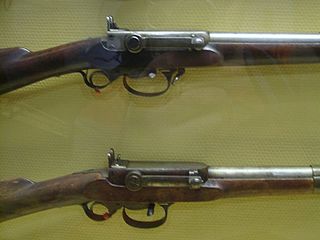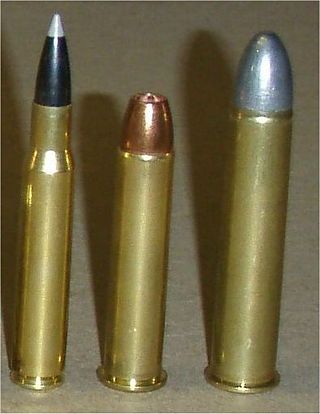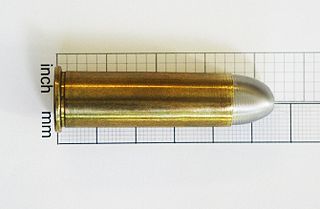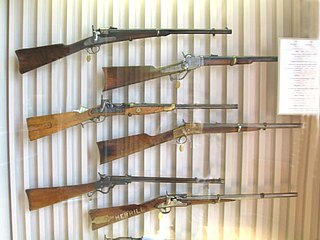
Single-shot firearms are firearms that hold only a single round of ammunition, and must be reloaded manually after every shot. The history of firearms began with single-shot designs, then multi-barreled designs appeared, and eventually many centuries passed before multi-shot repeater designs became commonplace.

In firearms terminology, an action is the functional mechanism of a breech-loading firearm that handles the ammunition cartridges, or the method by which that mechanism works. Actions are technically not present on muzzleloaders, as all those are single-shot firearms with a closed off breech with the powder and projectile manually loaded from the muzzle. Instead, the muzzleloader ignition mechanism is referred to as the lock.
The term Springfield rifle may refer to any one of several types of small arms produced by the Springfield Armory in Springfield, Massachusetts, for the United States armed forces.

A breechloader is a firearm in which the user loads the ammunition via the rear (breech) end of its barrel, as opposed to a muzzleloader, which loads ammunition via the front (muzzle).

The Remington M1867 was a rolling-block rifle, the first rifle using metallic cartridges to be adopted by the Norwegian and Swedish armies. Nominally it had a caliber of 4 decimal lines, but the actual caliber was 3.88 Norwegian decimal lines or 4.1 Swedish decimal lines (12.17 mm), and it fired a rimfire round with a 12.615 mm lead bullet. The 12.17 mm caliber was chosen because the Swedish army had approximately 30,000 new muzzle-loading M1860 and breech-loading M1864 rifles in 12.17 mm caliber in stock, rifles that were suitable for conversion to M1867 rolling-block rifles. With the exception of the first 10,000 rifles and 20,000 actions, which were made by Remington in the US, all Remington M1867 rifles and carbines were made under license in Norway and Sweden, by Kongsberg Vaapenfabrik in Norway, and by Husqvarna Vapenfabriks Aktiebolag and Carl Gustafs stads Gevärsfaktori in Sweden with the two Swedish manufacturers producing about 80% of the weapons.

The Kammerlader, or "chamber loader", was the first Norwegian breech-loading rifle, and among the first breech loaders adopted for use by an armed force anywhere in the world. A single-shot black-powder rifle, the kammerlader was operated with a crank mounted on the side of the receiver. This made it much quicker and easier to load than the weapons previously used. Kammerladers quickly gained a reputation for being fast and accurate rifles, and would have been a deadly weapon against massed ranks of infantry.

The .45-70 rifle cartridge, also known as the .45-70 Government, was developed at the U.S. Army's Springfield Armory for use in the Springfield Model 1873, which is known to collectors as the "Trapdoor Springfield." The new cartridge was a replacement for the stop-gap .50-70 Government cartridge, which had been adopted in 1866, one year after the end of the American Civil War.

Edward Maynard was an American firearms inventor, most famous for his breechloading rifle design.

The M1819 Hall rifle was a single-shot breech-loading rifle designed by John Hancock Hall, patented on May 21, 1811, and adopted by the U.S. Army in 1819. It was preceded by the Harpers Ferry M1803. It used a pivoting chamber breech design and was made with either flintlock or percussion cap ignition systems. The years of production were from the 1820s to the 1840s at the Harpers Ferry Arsenal. This was the first breech-loading rifle to be adopted in large numbers by any nation's army, but not the first breech-loading military rifle – the Ferguson rifle was used briefly by the British Army in the American Revolutionary War. The Hall rifle remained overshadowed by common muskets and muzzleloading rifles which were still prevalent until the Civil War. The early flintlocks were mostly converted to percussion ignition.
The Springfield Model 1873 was the first standard-issue breech-loading rifle adopted by the United States Army. The gun, in both full-length and carbine versions, was widely used in subsequent battles against Native Americans.

The Springfield Model 1865 was an early breech-loading rifle manufactured by U.S. Armory in Springfield, Massachusetts. It was a modification of the Springfield Model 1861. It was later replaced with the Springfield Model 1866.

The Springfield Model 1866 was the second iteration of the Allin-designed trapdoor breech-loading mechanism. Originally developed as a means of converting rifle muskets to breechloaders, the Allin modification ultimately became the basis for the definitive Springfield Model 1873, the first breech-loading rifle adopted by the United States War Department for manufacture and widespread issue to U.S. troops.

The Springfield Model 1870 was one of the rifles which used the trapdoor breechblock design developed by Erskine S. Allin. The Model 1870 was a minor improvement to the Springfield Model 1868, and retained most of the Model 1868 rifle features.

The Springfield Model 1868 was one of the rifles which used the trapdoor breechblock design developed by Erskine S. Allin.

The .50-70 Government is a black powder cartridge adopted in 1866 for the Springfield Model 1866 trapdoor rifle.
The Springfield Model 1870 rolling-block U.S. Navy rifle was a shipboard small arm for use by the United States Navy, employing the Remington Arms Company rolling-block design, and manufactured under a royalty agreement with Remington.

The Starr carbine was a breechloading single-shot rifle used by the United States Army. Designed in 1858, the Starr was primarily used by cavalry soldiers in the American Civil War.
The Winchester Hotchkiss was a bolt-action repeating rifle patented by Benjamin B. Hotchkiss in 1876 and produced by the Winchester Repeating Arms Company and Springfield Armory from 1878. The Hotchkiss, like most early bolt-actions, had a single rear locking lug integral with the bolt handle, but was unique in feeding multiple rounds from a tubular buttstock magazine similar to the Spencer rifle. The .45-70 Hotchkiss was acquired in limited numbers by the US Navy as the M1879, and by the US Army and several state militias as the M1883, making it the first center-fire bolt-action repeater to be adopted by any major military.
The Springfield Model 1869 was one of several model "trapdoor Springfields", which used the trapdoor breechblock design developed by Erskine S. Allin.
The term Joslyn Rifle refers to a series of rifles produced in the mid-19th century. The term is often used to refer specifically to the Joslyn Model 1861/1862, which was the first mass-produced breech-loading rifle produced at the Springfield Armory.
















